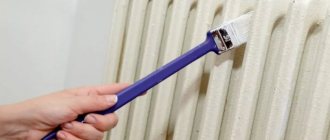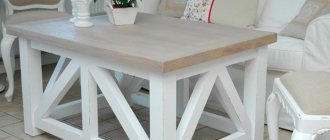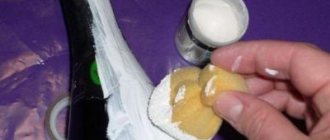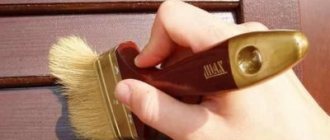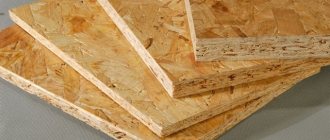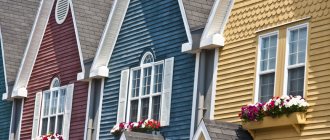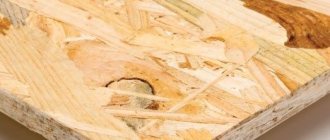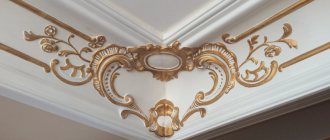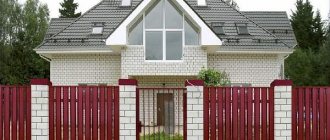A log house attracts people due to the naturalness of the material. However, the owners of such a structure must carry out protective finishing. Typically, painting a house made of timber is used. It helps improve external characteristics, and external paints for timber can create a protective coating from the effects of negative environmental factors. The dyeing process will be described in detail below.
General painting rules
Painting the outside of a log home may seem like an easy job. However, in order to get a high-quality and durable result, you should know the general rules of operation. The following points can be noted when painting a wood surface:
- The surface is sanded, it is more convenient to use a grinder, the process will go faster. Even fresh material should be sanded a little. Afterwards, the dust is removed with a vacuum cleaner, paying special attention to the seams;
- Apply protective agents - antiseptic and fire-fighting. You should make 2-3 layers;
- After priming, when the layer dries, they proceed to painting the timber. For best results, apply at least two layers.
The paint and varnish material can be applied to completely dried timber; they usually work in the summer.
Even fresh material should be sanded a little.
Features of the harmful effects of the environment
It is recommended to paint wood due to the need to protect the surface from many harmful natural factors to which the façade of a house is constantly exposed. The following impacts can be identified:
- Water has a destructive effect on a wooden structure; over time, the material becomes covered with unsightly stains and stains appear. The result will be darkening and deterioration of integrity;
- Ultraviolet radiation also leads to a change in surface color;
- Insects and pests destroy the tree;
- Humidity can lead to biological formations.
You need to move on to coloring faster; usually you can wait no more than 3-4 months.
It is recommended to paint wood due to the need to protect the surface from many harmful natural factors to which the façade of a house is constantly exposed.
Varieties of painting compositions for exterior use
Before painting the outside of a timber house, you need to study the range of products offered by manufacturers. There are two types of substances suitable for this purpose - impregnation and paint.
Before painting the outside of a timber house, you need to study the range of products offered by manufacturers.
Antiseptic impregnations and solutions
Antiseptic impregnations help create a barrier against the formation of mold and fungi on the surface of wood. They penetrate deeply into the wood structure, creating a protective layer.
Fireproofing solutions are also commercially available that reduce the flammability of wood, which is known to burn quickly. They are called fire retardants.
Antiseptic impregnations help create a barrier against the formation of mold and fungi on the surface of wood.
Expert opinions
Wood is becoming the most popular and in-demand material for building houses. A log house made of logs or beams is breathable, environmentally friendly, and capable of independently regulating the microclimate in the room. In order for a wooden house to last for a long time, it is necessary to carry out high-quality surface treatment and finishing, but at the same time, their environmental characteristics should not be violated. All paint and varnish products can be divided into two types:
- Natural impregnations that are ideal for painting residential buildings.
- Synthetic paints. They can be used to paint benches, fences, gazebos, etc.
After painting, the wood can become matte or glossy, it all depends on the decorative composition used. Some paints include components that protect against mold and mildew. The base for the paint can be any, but for wood it is recommended to use water-based impregnations that are odorless and environmentally friendly. For each wooden surface in a log house you need to use different types of paints. For example, for a floor it must be wear-resistant and moisture-resistant for rooms with high air humidity.
For residential premises, it is recommended to use acrylic paints that do not contain harmful substances and do not have a negative impact on the health of residents. Such a glazing impregnation is Biocolor Aqua from the Russian company Neomid. It does not have a pungent or unpleasant odor. Dries quickly and protects the wooden surface from moisture and dirt. The composition contains natural microwax, which makes the coating elastic and does not crack even when the material is deformed. Forms a semi-matte, translucent layer. Protects against rot, mold and insects. The paint palette is varied, there are light shades:
- golden pine-
- light oak-
- white-
- cedar-
- blue spruce-
- frosty sky.
And dark shades:
- mahogany-
- wenge-
- maple.
For exterior painting of a log house, you can use alkyd paints that are more resistant to weathering. Of the entire existing range, Biocolor Ultra and Classic paints from the same company Neomid stand out. They protect the wooden surface from the sun's ultraviolet rays and prevent cracking of the material. They protect wood from moisture thanks to the microwax contained in the composition. Biocolor Classic forms a semi-matte layer on a wooden surface, and Ultra semi-gloss. Glazing impregnations penetrate deep into the wood structure and protect it from biological pests. The palette consists of 9 shades, including colorless. You can choose both dark colors (teak, rowan, walnut, mahogany) and light ones (Oregon, marigold, oak). If desired, the paints can be tinted using special pastes.
Types of paints for timber houses
The modern market offers a huge number of paints and varnishes that can create not only a decorative coating on wood, but also serve as protection against natural factors. The options differ in their properties and may be suitable for different situations.
The modern market offers a huge amount of paint and varnish materials.
Latex
This type is suitable for working with wood. They obtain a reliable coating that is distinguished by a high level of adhesion, protection against mold and mildew, safety, vapor permeability, mechanical protection, and elasticity.
However, they do not withstand exposure to low temperatures.
They receive a reliable coating that is distinguished by a high level of adhesion, protection against mold and mildew, and safety.
Acrylic
A popular type that has an affordable price. High levels of protection against various phenomena, as well as the durability of the coating, distinguish this product from others. The surface can be washed with abrasive agents. The composition dries quickly, but this can also be called a disadvantage. The composition in an open container must be applied within 5-6 hours for it to remain of high quality.
They receive a reliable coating that is distinguished by a high level of adhesion, protection against mold and mildew, and safety.
Oily
The protective properties of oil paints are high, and the color palette is varied. But they emit a pungent odor, take a long time to dry, are also not resistant to ultraviolet radiation, and the coating does not last long.
The protective properties of oil paints are high, and the color palette is varied.
Alkyd
The alkyd composition helps protect the wood from moisture, frost and other external factors. But it is difficult to adhere to the base and does not allow air to pass through.
The alkyd composition helps protect the wood from moisture, frost and other external factors.
Rubber
A new type of paint that has a number of positive aspects and no negative ones. Excellent for wooden bases. They last a long time. The high price is probably the only negative, but it is justified by the resulting properties.
Excellent for wooden bases.
Main stages of painting
To get the desired result you need to do some preparatory work. It will help improve grip. The next stage is directly applying the selected composition.
To get the desired result you need to do some preparatory work.
Preparing for painting
The house is prepared for processing by first grinding. After which it is necessary to thoroughly vacuum the surface. They polish the walls and clean them of dirt. Next, primer mixtures with antiseptic properties can be applied. They must be completely dry before the next step.
The house is prepared for processing by first grinding.
Impregnation and painting
It is recommended to paint in dry weather. Keep the surface dry. The substance can be applied with a brush, roller, or spray gun. It is more convenient to work with the latter; the process will not take much time. Usually several layers of paint are applied. Each layer must dry before the next.
Paint consumption can be calculated; the average is indicated by the manufacturer on the packaging. You need to know how many square meters will be painted.
It is recommended to paint in dry weather.
Compositions for interior painting works
When working indoors, the main thing is the safety of the equipment for humans. Therefore, when purchasing, pay attention to the manufacturer’s instructions to determine whether they are suitable for this painting. In rooms with high humidity, it is important to create protection against moisture.
When working indoors, the main thing is the safety of the equipment for humans.
Wax and mastic
You can treat the wood with wax to provide a protective function. It may be colorless or slightly change the tone of the surface. The shade will be known only after drying. Therefore, it is advisable to test the product by applying a small amount to the surface.
You can treat the wood with wax to provide a protective function.
Recommendations for choosing paint
It is important to obtain the desired result after painting not only the correct choice of paint, but also the selection of shade. There is a wide range of colors on the market; any idea can be turned into reality. But at the same time, it is recommended to listen to the professionals. If the building is entirely built of wood and there are no other finishing materials in the interior, then you should choose paints in natural shades for interior work. It could be oak, pine, cedar, maple, etc. You should not purchase colored matte paint, which will hide the natural appearance of the material and its unique structure. Such paints will only hide the dignity of the material. If the walls inside the room were decorated with clapboard, then you can use colorless glaze impregnations or varnishes; they will give the surface a beautiful, glossy shine.
The color of the facade of the house is also important, because it is believed that it is the face of its owners. It is recommended to paint timber walls in a dark color, although light colors can be used if desired. But still, dark ones attract the sun's ultraviolet rays to a lesser extent, which helps protect the wooden material from cracking, etc.
Lucky
Varnishes leave the natural color of the timber, creating a glossy or matte effect. Serve as a protective option. There are many types of varnishes; the choice should be made based on operating conditions. Apply the same as paint.
Varnishes leave the natural color of the timber, creating a glossy or matte effect.
How to choose a color for a timber house
The color of the coating should be chosen to match the style of the room. It is not difficult to choose the appropriate option in order to get a good combination with other buildings and structures, because the range is huge. There are any colors from black, chocolate to green, red, gold. Classically, the natural color of the wood is left by applying transparent compounds.
The color of the coating should be chosen to match the style of the room.
Choosing paint for a log house
Conditionally coloring compositions can be divided into several types. They are not necessarily pigmented, but each of them performs protective functions. So:
- Antiseptics.
- Glazing compounds.
- Topcoating and pigmented paints.
More details:
- Antiseptics include compounds that can protect a home from external influences and biological threats. This includes water-repellent paints, varnishes, and impregnations. They contain oils that clog the capillaries of the wood, thereby preventing drops from penetrating inside.
Do not forget that such substances contain toxic substances. They act as a poison on certain types of biological activity - clutches of bark beetles, rodents and other species. Therefore, it is imperative to follow safety precautions when applying: choose dry, windless weather, use personal protective equipment, apply the next layer only after the previous one has completely dried.
- Glazing compounds are coatings that allow you to see the natural grain of wood. These include varnishes, impregnations, wax mastics and others. Some of them are applied hot. The most common is varnish.
To preserve the environmental component, a water-based composition should be used. These are new generation drugs, labeled as eco-friendly, have no odor or other effects. They are used mainly indoors, thereby creating safe operating conditions.
- Coating or pigmented materials - oil, acrylic and PF paints of different shades. Allows you to create an individual look for your home. Many of them contain antiseptics, so applying such products can provide a double service - protection and beauty.
High-quality paint for a log house can be prepared independently if the owners are committed to environmental friendliness. The use of decoctions to help wood highlight its own pattern is quite common. However, this does not exclude anti-parasitic layers under the applied structure - the appearance without protective materials will not last long.
How to paint a log house
When the owners come to one decision - how to paint a log house, they should take care of the correctness of the process. It consists of several stages:
- Cleaning walls to be painted. This includes not only the removal of dirt and debris, but also a detailed examination of surfaces for damage - rot, mold, beetle nests. It is also worth sealing cracks before the procedure - gaps can allow water to stagnate in the cracks and then painting the log house will not help protect it.
Cracks, if they are small, can be sealed with a mixture of sawdust and wood glue. Others should be sealed with silicone raw materials.
If rottenness is obvious, then pieces of wood are cut out along with clean areas to prevent the spread of spores throughout the object, and new ones are inserted. In this case, the appearance is irretrievably lost and you cannot do without a coating composition.
- Before painting, it is necessary to sand the surfaces. If you do this manually, you can quickly get tired, but the result will be beyond praise. To speed up the process, mechanical means should be used. They start from the top in order to sweep away waste with probably existing fungal spores.
- Next, apply protective compounds, which act as a primer layer, and then paint the log house with the selected raw material. There are also rules here - glazing and coating materials are applied only along the logs, allowing the paint to penetrate deeper inside and reliably plug small cracks and pores.
We must not forget about the ends of the house. They cannot be covered with film compounds, keeping in mind that the wood breathes through them. Therefore, you should select an acrylic composition labeled specifically for such purposes.
Technology of painting a house made of timber
The stages of painting indoors and outdoors are slightly different. Before painting the outside of a log house, you need to learn the rules of the job.
Outside
On the outside, they begin by preparing the surface, cleaning it and sanding it. The surface is primed to improve adhesion and save coloring agent. After the primer layer has dried, paint is applied. The process is carried out as standard, paying attention to the ends and seams.
The surface is primed to improve adhesion and save coloring agent.
Inside
They immediately begin by cleaning the surface, then eliminate surface defects, apply antiseptic compounds, and carry out grinding. When the surface is vacuumed, paint is applied. It is important that each layer dries.
It is important that each layer dries.
Painting a house made of profiled or laminated timber
Glued and profiled timber has a higher cost. The grinding stage will be easier to carry out, and the base will be of better quality. It is advisable to apply antiseptic impregnation to the timber itself, before construction. Priming is necessary; it is better to paint the surface with oil, acrylic paints or varnishes.
It is prohibited to use water-based dyes due to the poor resistance of the material to moisture.
It is advisable to apply antiseptic impregnation to the timber itself, before construction.
Painting the timber is necessary to obtain reliable protection from natural influences. It is better to choose high-quality compositions; saving will lead to the paint peeling off quickly. And the material will last less. Painting can only be done after preparing the base.
Preparation for painting - wood processing
Before applying a paint layer, the walls of the house must be prepared ; the process includes processing and subsequent protection of the wood.
Processing is carried out in several stages :
- cleaning from dust, dirt, old paint layers, oil stains;
- grinding surfaces using a grinding machine;
- cleaning with brushes or blowing a vacuum cleaner.
A primer is applied to the prepared surface, providing fire protection and bioprotection of the wood, and an adhesive primer is applied on top of it.
Important: The quality and durability of the paint layer depends on the correct preparation of the base. Layers of primer must be applied on top of the dried previous layer.
The most common wood defects
- rotting of the end of the log;
- discoloration due to fungal or mold damage;
- corroded by wood-boring beetles, termites;
- rotting in high humidity conditions;
- fading in the sun;
- charring by fire.
Protective impregnations
Before transportation, freshly cut wood at logging sites is treated with temporary protection compounds with a validity period of about six months.
If wood is not treated with a protective compound during construction, it will quickly become unusable.
To protect wood from premature aging and damage, the following drugs :
- Antiseptics are means of bioprotection and treatment against fungi, algae, bacteria and insects.
- Fire retardants to impart fire retardant properties.
- Complex action drugs.
To protect and color wood, they offer compositions that differ in composition, texture and purpose; they can also be natural or organic.
Natural paints are harmless to humans and the environment, but are not durable and require renewal after 1-2 years, while synthetic compositions guarantee protection of wood for 7-35 years.
We recommend: How to choose the right designs for wooden one-story houses? DIY design and construction
